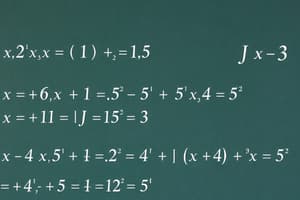Podcast
Questions and Answers
Which mathematical principle is primarily demonstrated by the equation $5(7 + 3)$?
Which mathematical principle is primarily demonstrated by the equation $5(7 + 3)$?
- Identity property
- Distributive property (correct)
- Commutative property
- Associative property
What is the result of simplifying the expression $12 - 4 + 3$?
What is the result of simplifying the expression $12 - 4 + 3$?
- 10 (correct)
- 8
- 9
- 11
If $x = 3$ and $y = 4$, what is the value of the expression $2x + 3y$?
If $x = 3$ and $y = 4$, what is the value of the expression $2x + 3y$?
- 21
- 22
- 20 (correct)
- 18
Which equation represents the inverse operation for addition?
Which equation represents the inverse operation for addition?
What is the correct interpretation of the expression $3(x + 4)$?
What is the correct interpretation of the expression $3(x + 4)$?
The ______ of an equation shows how two expressions are equivalent.
The ______ of an equation shows how two expressions are equivalent.
A ______ is a mathematical statement that asserts the equality of two expressions.
A ______ is a mathematical statement that asserts the equality of two expressions.
To ______ an equation means to isolate the variable on one side.
To ______ an equation means to isolate the variable on one side.
In mathematics, a ______ is any numeral or symbol that represents a value.
In mathematics, a ______ is any numeral or symbol that represents a value.
The ______ of addition is subtraction.
The ______ of addition is subtraction.
Flashcards are hidden until you start studying
Study Notes
Distributive Property
- The equation 5(7+3)5(7 + 3)5(7+3) demonstrates the distributive property of multiplication over addition.
- The distributive property states that multiplying a sum by a number is the same as multiplying each addend by the number and then adding the products.
Order of Operations
- To simplify the expression 12−4+312 - 4 + 312−4+3, we follow the order of operations, often remembered by the acronym PEMDAS (Parentheses, Exponents, Multiplication and Division, Addition and Subtraction).
- Therefore, we first perform the subtraction: 12−4=812 - 4 = 812−4=8, and then the addition: 8+3=118 + 3 = 118+3=11.
Evaluating Expressions
- Given x=3x = 3x=3 and y=4y = 4y=4, we substitute these values into the expression 2x+3y2x + 3y2x+3y.
- This gives: 2(3)+3(4)=6+12=182(3) + 3(4) = 6 + 12 = 182(3)+3(4)=6+12=18.
Inverse Operation
- The inverse operation for addition is subtraction.
- Subtraction "undoes" addition, meaning that adding a number and then subtracting the same number results in the original number.
Interpreting Expressions
- The expression 3(x+4)3(x + 4)3(x+4) represents multiplying the quantity (x+4)(x + 4)(x+4) by 3.
- This means that we distribute the multiplication to both terms inside the parentheses: 3(x+4)=3x+123(x + 4) = 3x + 123(x+4)=3x+12.
The Distributive Property
- The equation $5(7 + 3)$ demonstrates the distributive property of multiplication over addition. This property states that multiplying a sum by a number is the same as multiplying each addend by the number and then adding the products.
Order of Operations
- To simplify $12 - 4 + 3$, follow the order of operations, which is often remembered by PEMDAS (Parentheses, Exponents, Multiplication and Division, Addition and Subtraction):
- $12 - 4 + 3 = 8 + 3 = 11$
Evaluating Expressions
- If $x = 3$ and $y = 4$, substitute these values into the expression $2x + 3y$ and evaluate:
- $2(3) + 3(4) = 6 + 12 = 18$
Inverse Operations
- The equation representing the inverse operation for addition is subtraction:
- $a + b = c$ is equivalent to $c - b = a$
Simplifying Expressions
- The expression $3(x + 4)$ is a combination of multiplication and addition. It can be interpreted as:
- Multiplying the sum of $x$ and $4$ by $3$, or
- Distributing the $3$ to both terms inside the parentheses: $3x + 12$
Equations
- The equal sign of an equation shows how two expressions are equivalent.
- An equation is a mathematical statement that asserts the equality of two expressions.
- To solve an equation means to isolate the variable on one side by performing inverse operations on both sides.
Mathematical Terms
- In mathematics, a constant is any numeral or symbol that represents a value.
- The inverse of addition is subtraction, meaning they undo each other.
Studying That Suits You
Use AI to generate personalized quizzes and flashcards to suit your learning preferences.




